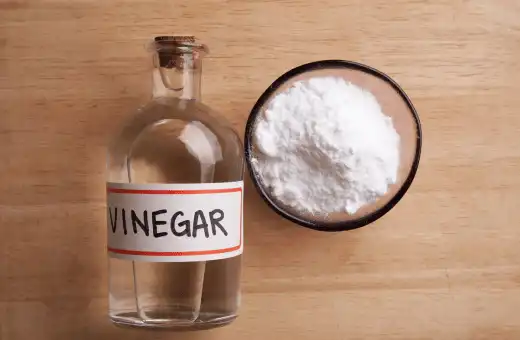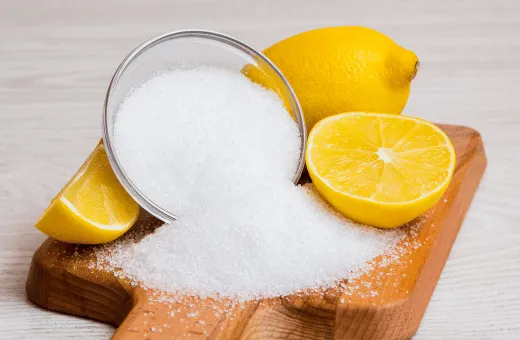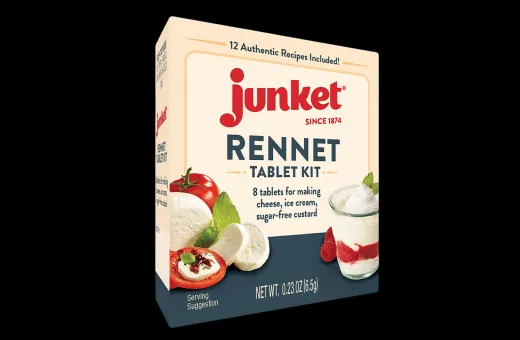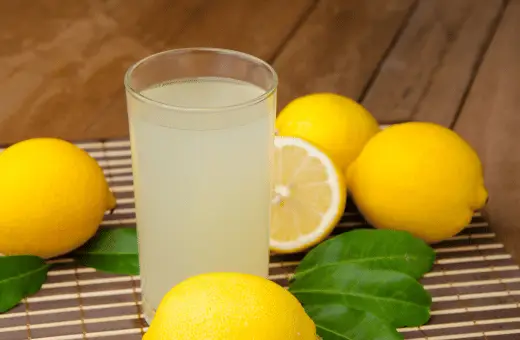Mozzarella is the most widely used cheese in the world, especially when making pizza.
However, one of the key ingredients to make it possible is Rennet, an enzyme used as a traditional coagulant to curdle the milk.
But what if you do not have Rennet? What if you are a vegan?
Or what if you can’t find it anywhere, and you need to prepare your mozzarella quickly? Don’t worry!
As an experienced home cook and chef, I understand the struggle of finding the perfect ingredients.
Therefore, I have compiled a list of 15 ideal Rennet substitutes for Mozzarella recipe. These substitutes are easy to find and use, so let’s dive in!
In short, " What I Can use instead of rennet in Mazzarella?" Vinegar, Lemon Juice, Buttermilk, Yogurt, Citric Acid, Vegetarian Rennet, Rennet Tablets, Junket, Malt Vinegar, Microbial Rennet, Fermentation-produced Chymosin (FPC), Citric Acid and many more.
What is Rennet, and what does Rennet use for?
Rennet is a complicated set of enzymes produced in any mammalian stomach to digest a mother’s milk. This recreates a vital role in the production of cheese.
The primary enzyme in Rennet is called chymosin or rennin, which curdles the casein in milk. It helps young mammals digest their mothers’ milk.
Rennet used in cheese making traditionally comes from the stomach lining of young, unweaned calves.
However, because of dietary restrictions and supply issues, other forms of Rennet have been developed.
In cheese making, Rennet is used to separate milk into solid curds (used for cheese making) and liquid whey.
The Rennet causes the milk to coagulate, trapping the fats and proteins from the milk into the curds. These curds are then further processed and aged to produce cheese.
Besides traditional animal rennet, there are also vegetable rennets and microbial rennets. Vegetable rennets are derived from certain plants with coagulating properties, such as fig trees or thistles.
Microbial rennets are produced by certain fungi or bacteria. There are also genetically engineered rennets, which are made by inserting genes that produce chymosin into bacteria, fungi, or yeasts.
Although Rennet is most commonly associated with cheese making, it can also be used in making other products like junket, a type of dessert made from sweetened, flavored, and coagulated milk.
Where to buy Rennet?
You are searching for where to buyRennet; there are some other places to go. Many specialty food stores carry it, as do some international grocery stores.
You can also order online from many retailers that provide a variety of diverse flavors and types of Rennet.
Best rennet substitutes for mozzarella & way to use
1. Vinegar

Vinegar is a suitable substitute for Rennet. Although it is not traditional Mozzarella-making, it will work perfectly fine and give you the required texture.
Vinegar is the perfect replacement if you want to achieve that tangy-sour flavor in your cheese.
Start by heating milk to 185 degrees Fahrenheit, then add the vinegar little by little until you see the curds start to appear, then let the mixture rest.
After 15 minutes, strain the curds using cheesecloth or a strainer, microwave for about 1 minute, and knead the curds until they turn into mozzarella cheese.
Discover more: Best substitutes for Red wine vinegar
2. Lemon Juice
If you don’t have vinegar within reach, you can also substitute it with lemon juice. Lemon juice is an acidic substance that will help coagulate the milk and give you the desired texture.
To make mozzarella using lemon juice, heat the milk to 185 degrees Fahrenheit, then add lemon juice and let the mix sit for 15 minutes.
Once you see that the curds are separated, scoop them out and let them sit in a strainer for another 15 minutes.
Finally, microwave the curds on a plate for 1 minute and knead them until you have the desired consistency.
3. Buttermilk

Buttermilk is made from cultured milk, and it contains traces of Rennet. These traces of Rennet can curdle the milk and give you the perfect texture for making Mozzarella cheese.
Add a cup of buttermilk to your warm milk, stir properly, then wait for the curd to form.
4. Yogurt
Yogurt is another excellent substitute for Rennet, and it’s readily available in most homes. Using yogurt as a substitute, you can have your Mozzarella cheese recipe ready in no time.
Combine four tablespoons of yogurt with a cup of warm milk, stir well, and keep it in a warm place. Wait for an hour to let the milk curdle before draining the curd.
5. Citric Acid

Citric acid is another perfect substitute for Rennet, and it gives cheese that tangy taste. Dissolve one teaspoon of citric acid in warm water and slowly add it to the milk, stirring gently until the curd separates from the whey.
Let the mix set for 15 minutes, then strain the curd using cheesecloth. Microwave the curds for a minute, and knead until the cheese is smooth and has the desired consistency.
6. White Vinegar and Baking Soda
If you don’t have vinegar or lemon juice, a white vinegar and baking soda mixture can give you the same result.
One tablespoon of baking soda mix with 2 tablespoons of white vinegar and add to one cup of warm milk. Wait for the milk to curdle. Once it has curdled, remove the whey from the curds using a cheesecloth.
7. Vegetarian Rennet
Suppose you’re a vegetarian and you don’t want to use any of the above-listed substitutes. In that case, you can purchase vegetarian Rennet, which is entirely non-animal-based and free from any animal products.
It’s extracted from the sap of certain tropical plants or artificially produced.
8. Rennet Tablets

If you can’t find liquid Rennet, rennet tablets are available in many stores. Crush up the tablet and dissolve it in water, then pour it into the warm milk to make mozzarella.
9. Junket
Junket is a dessert mix that is often made with Rennet. It can use as an alternative to Rennet for cheesemaking.
Add half a cup of warm water to the junket mix and pour it into the warm milk. You will need to wait for 30-45 minutes for the cheese to curdle.
10. Malt Vinegar
Malt vinegar can be an excellent alternative source of acetic acid to make cheese curd. Add a few teaspoons of malt vinegar to warm milk and let it rest for about 10 minutes until curdling occurs.
Once the curd is strained, you can heat it up and stretch it into mozzarella cheese.
vegetable rennet substitute for mozzarella
If you’re seeking alternatives to animal-derived Rennet for making mozzarella, there are several options available:
1. Microbial Rennet
Microbial Rennet is derived from molds or yeasts and can be used as other substitutes for animal rennet in cheese making.
However, it can occasionally impart a slightly bitter flavor if the cheese is aged, which is not a problem with fresh cheeses like mozzarella.
2. Fermentation-produced Chymosin (FPC)
This is a type of genetically engineered Rennet that’s often used in commercial cheese production. It’s created by inserting the gene for rennet production into certain bacteria or yeast.
3. Citric Acid
For some cheeses like mozzarella, citric acid can be used to achieve the coagulation effect needed for cheese making. It’s often used in combination with heat.
4. Lemon Juice or Vinegar

Like citric acid, both lemon juice and vinegar are acids that can help milk coagulate. However, they can change the flavor of the cheese, so they’re not suitable for all types.
5. Vegetable Rennet
Vegetable rennet is derived from certain plants that have coagulating properties, like fig tree bark, nettles, thistles, or mallow.
However, their efficiency can be inconsistent, and they can impact the flavor of the cheese.
Is Rennet necessary for mozzarella cheese?
Traditionally, Rennet is used in the cheesemaking process, including mozzarella, to coagulate the milk, separating it into curds and whey.
The curds, which contain milk proteins and fat, are then processed and stretched to create the smooth, elastic texture characteristic of mozzarella cheese.
However, it is possible to make a form of mozzarella without Rennet. This is often referred to as “quick” mozzarella, “acid-set” mozzarella, or “fresh” mozzarella.
In this process, an acid like citric acid or vinegar is used instead of Rennet to coagulate the milk.
This results in a softer, more spreadable cheese that’s somewhat similar to traditional mozzarella but lacks the stretchy, stringy texture of rennet-set mozzarella.
So, while Rennet is not absolutely necessary to make a form of mozzarella, it does play a significant role in developing the texture and characteristics that are typically associated with this type of cheese.
How to substitute vinegar for Rennet?
Vinegar can use as a substitute for Rennet in the cheesemaking process, particularly for soft, fresh cheeses like ricotta or paneer.
It’s important to note that the resulting cheese may have a slightly additional texture and flavor compared to cheese made with Rennet.
Here is a basic way you can use vinegar as a substitute for Rennet:
1. Heat your milk: Pour your milk into a large, heavy-bottomed pot and heat it over medium heat until it gets a temperature of about 185-195 degrees Fahrenheit (85-90 degrees Celsius). Stir it regularly to prevent the milk from scorching.
2. Add vinegar: Once the milk has reached the correct temperature, slowly add vinegar while stirring. The amount of vinegar needed will depend on the type and amount of milk, but a general guideline is about 1/4 cup of vinegar for every gallon of milk.
3. Let the milk curdle: After the vinegar is added, the milk should begin to curdle almost immediately. Decrease the heat to lower and let the mix rest for a few minutes to allow the curds to fully form.
4. Strain the curds: Pour the curdled milk through a strainer lined with cheesecloth to split the curds from the whey. You can then move with your recipe as directed, pressing and shaping the curds as necessary.
Remember, this method is more suitable for making fresh, soft cheeses and might not work as well for aged cheeses or cheeses with a more complex flavor profile, like cheddar or gouda.
how to create mozzarella cheese with vinegar without Rennet
Making mozzarella cheese with vinegar instead of rennet results in a softer, less stretchy cheese, but it’s still a tasty homemade dairy product. Here is a simple recipe for vinegar-based mozzarella:
Ingredients:
– 1 gallon of milk (not ultra-pasteurized, as it doesn’t curdle well)
– 1/2 – 3/4 cup of distilled white vinegar
– 1-2 teaspoons of salt (to taste)
Instructions:
1. Pour the milk into a large, heavy-bottomed pot. Heat it over medium until it reaches a temperature of about 185-195 degrees Fahrenheit (85-90 degrees Celsius). Stir it regularly to prevent this from scorching.
2. Once the milk reaches the correct temperature, slowly stir in the vinegar. Start with 1/2 cup, then add more if the milk doesn’t curdle.
3. The milk should begin to curdle almost immediately. Decrease the heat to lower and let the mix rest for a few minutes to allow the curds to fully form.
4. Pour the curdled milk through a strainer lined with cheesecloth to separate the curds from the whey. Let the curds drain until they form a semi-solid mass.
5. Once the curds have drained, sprinkle them with salt and gently mix it in. At this point, the cheese is prepared to eat, although the texture will be crumblier and less elastic than traditional mozzarella.
Can I make my own Rennet?
Making your own Rennet at home can be a complex process, as traditional animal rennet comes from the stomach lining of a ruminant animal, such as a calf or goat, which requires slaughtering the animal.
However, there are traditional ways of making vegetable rennet using certain types of plants.
Here’s a simple method using nettles:
1. Gather a large bunch of fresh nettles.
2. Rinse the nettles to remove any dirt or bugs, then chop them up finely.
3. Place the chopped nettles in a large pot and cover them with water.
4. Bring the water to a boil, lower the heat and let this for about 30 minutes to an hour.
5. strain the liquid via a fine-mesh sieve or cheesecloth into a jar or other container after simmering.
6. The resulting liquid can be used as a form of vegetable rennet in cheese making.
Remember, vegetable rennet may not work as efficiently as animal rennet.
Conclusion on rennet substitute for mozzarella
In conclusion, as we have learned, there are many ideal substitutes for Rennet in making Mozzarella cheese.
The ingredients listed are easy to find and use, so you don’t need to lose hope when you run out of Rennet.
Try any of these substitutes, follow the steps correctly, and enjoy your homemade Mozzarella cheese.
My professional advice as an experienced home cook and chef is always to experiment with different substitution options and don’t be afraid to make mistakes.
Happy cooking, cheese lovers!
FAQs on rennet substitute for mozzarella
Q1. What is similar to Rennet?
Fermentation-produced chymosin (FPC) and microbial Rennet are two substances similar to traditional animal rennet.
FPC is a genetically-engineered enzyme identical to chymosin, the active enzyme in Rennet, while microbial Rennet is derived from molds or yeasts and contains enzymes that perform a similar function to chymosin in cheesemaking.
Q2. Can cheese be made without Rennet?
Yes, cheese can indeed be made without Rennet. Acid-set cheeses, like cottage cheese, ricotta, and paneer, use vinegar or lemon juice to coagulate the milk instead of Rennet. Similarly, some types of soft and fresh cheeses can also be made using acids.
However, for making aged, hard cheeses, Rennet is typically used because it provides a different type of coagulation that results in a firmer curd suitable for aging. It’s important to note that the texture and flavor of cheeses made without Rennet may differ from those made with Rennet.

